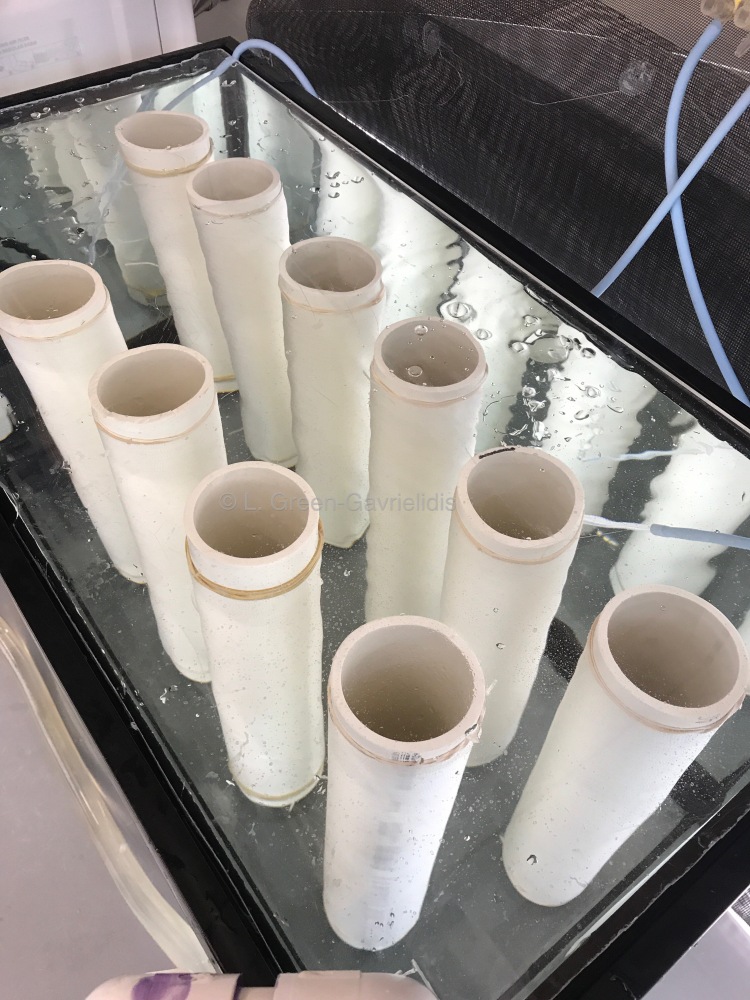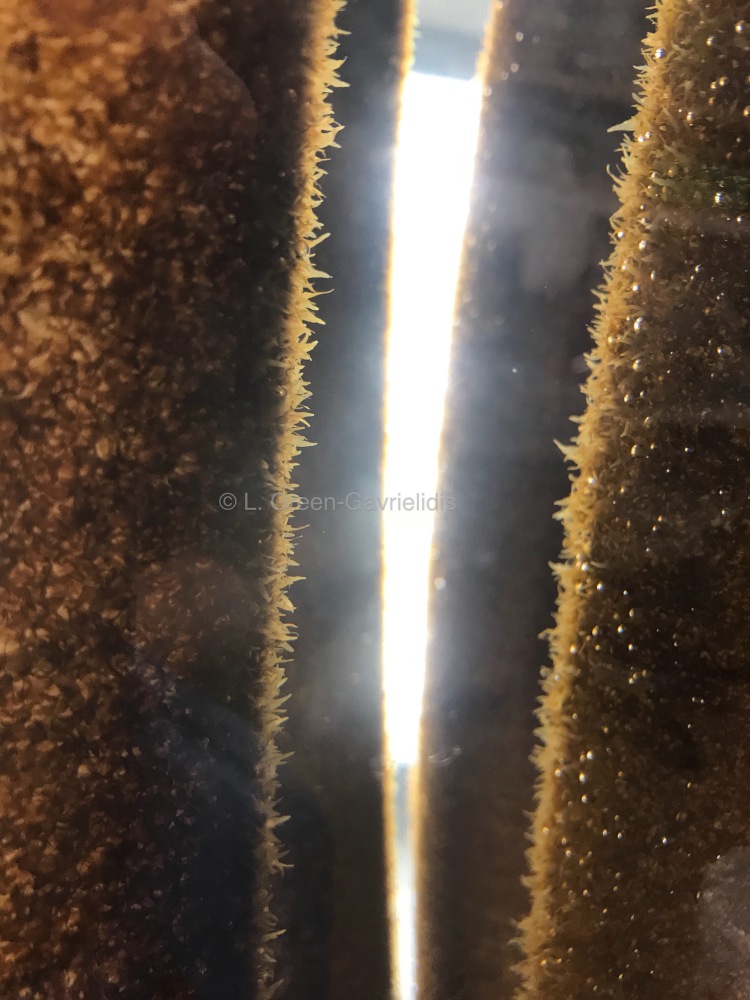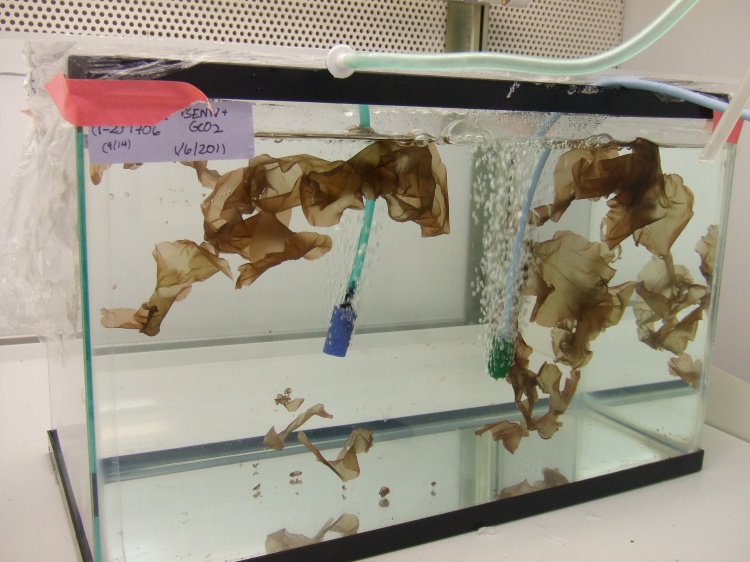Seaweeds represent an environmentally sustainable crop for aquaculture and interest in cultivating seaweeds in New England has been increasing rapidly over the last decade. Seaweeds can be cultivated alone or in combination with finfish and shellfish operations. In integrated multi-trophic aquaculture systems, organisms from different trophic levels are co-cultured, with the inorganic and organic nutrients produced by finfish extracted from the water and turned into biomass by seaweeds and shellfish, respectively. Seaweeds grown in monoculture or in co-culture with shellfish can also be used as bioremediators of coastal ecosystems which are heavily influenced by nutrient pollution from land-based activities.
Kelp-oyster co-culture in Rhode Island
Dr. G worked with collaborators at the University of Rhode Island and commercial shellfish farmers to incorporate seaweeds (e.g. kelp) into existing shellfish farms. This project, which was funded by the NOAA Saltonstall-Kennedy Program from 2017-2019, was titled “Optimizing seaweed and shellfish integrated multi-trophic aquaculture: developing a spatially explicit ecosystem model”. The primary goal of this research was to establish multiple kelp-oyster co-culture systems throughout Rhode Island and collect data that can be used to produce a model that will allow growers to determine suitable sites to co-culture kelp and shellfish (primarily oysters).
In 2016, we established a kelp nursery at the University of Rhode Island to produce seed string. Microscopic kelp gametophytes were cultured from wild-collected reproductive kelp blades. Over the course of 6 weeks, kelp gametophytes completed their sexual life cycle on the seed string, resulting in kelp sporophytes (macroscopic blades) approximately 5 mm in length. In 2017, we’ve expanded our seed spool production and have a nursery capable of producing 30+ kelp spools which are approximately 200 ft long each.
PVC spools seeded with kelp spores in the nursery. These spores grow into microscopic male and female gametophytes that will grow and reproduce over the course of several weeks. After approximately three weeks, kelp blades (sporophytes) will begin to appear on the string.
Kelp seed string after 6 weeks of nursery culture, with kelp sporophytes approximately 5 mm in length. When sporophytes reach this size, they are ready to be planted on the farm.
 Kelp grown during the winter of 2016-2017 in collaboration with Cindy West. At harvest, kelp blades were 1-2 m in length (May 2017).
Kelp grown during the winter of 2016-2017 in collaboration with Cindy West. At harvest, kelp blades were 1-2 m in length (May 2017).
Kelp grown during the winter of 2016-2017.
Kelp spools in the nursery during the fall of 2017. The air bubbles are a result of photosynthesis!
Kelp grows very fast! This kelp was planted in November 2017 and was over a meter long by February 2018.
Land-based cultivation of nori
In order to successfully cultivate seaweeds, intricate knowledge of the biology and life history of each species is required. The ability to supply mass quantities of seed stock to aquaculture facilities is also an important step towards commercial scale cultivation. Dr. G’s doctoral research focused on 1) determining the optimum growing conditions for two native species of the economically important red seaweed nori from New England, 2) determining the environmental triggers that allow for advancement through the life history of these species, and 3) developing a simple and reliable protocol for the mass preservation of seed stock to supply commercial aquaculture operations. An important part of her research was communicating her findings to interested stakeholders though participation in local, regional, national, and international conferences. Dr. G was also part of a research team that developed an open-access handbook that describes how to establish a seaweed nursery for New England nori and other species of economically important seaweeds.
Publications
Venolia, C.T., R. Lavaud, L. A. Green-Gavrielidis, C. Thornber, and A. Humphries. 2020. Modeling the growth of sugar kelp (Saccharina latissima) in aquaculture systems using dynamic energy budget theory. Ecological Modelling, 430: 109151, https://doi.org/10.1016/j.ecolmodel.2020.109151.
Green, L.A. and C.D. Neefus. 2016. Effects of temperature, light level, and photoperiod on the physiology of Porphyra umbilicalis Kützing and implications for aquaculture. Journal of Applied Phycology, 28(3): 1815-1826. Click here for the online version
Green, L.A. and C.D. Neefus. 2015 Effects of temperature, light level, photoperiod, and nitrogen concentration on Pyropia leucosticta (Thuret) Neefus & J. Brodie from the Northwest Atlantic. Journal of Applied Phycology, 27(3): 1253-1261. Click here for online version; Green&Neefus2016_AAM
Green, L.A. 2014. Physiological studies of cultured New England nori Porphyra umbilicalis Kützing and Pyropia leucosticta (Thuret) Neefus & J.Brodie, and implications for use in integrated multi-trophic aquaculture systems. Ph.D. Dissertation, University of New Hampshire. Click here for online version
Green, L.A. and C.D. Neefus. 2014 The effects of short- and long-term freezing on Porphyra umbilicalis Kützing (Bangiales, Rhodophyta) blade viability. Journal of Experimental Marine Biology and Ecology, 461: 499-503. Click here for online version; Freezing_Green&Neefus_JEMBE_AAM
Redmond, S., L.A. Green, C. Yarish, J. Kim, and C.D. Neefus. 2014. New England seaweed culture handbook: nursery systems. Connecticut Sea Grant College Program. CTSG-14-01. 92 pp. Click here for online version
Redmond, S., L.A. Green, C. Yarish, J. Kim, and C.D. Neefus. 2013. Seaweed culture in New England. Connecticut Sea Grant College Program. http://s.uconn.edu/seaweedplaylist





